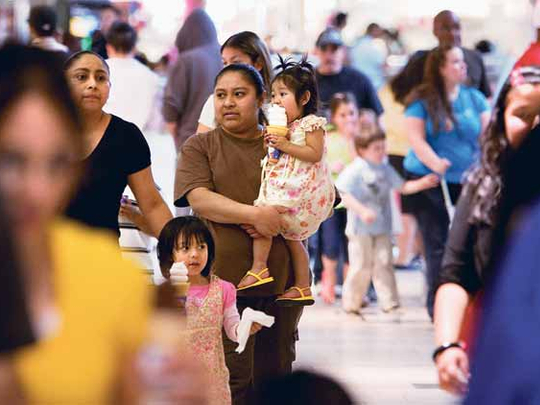
Washington: Sales at US retailers were unexpectedly strong last month, suggesting consumers were feeling a little more comfortable to spend and improving prospects for first-quarter economic growth.
Retail sales rose 0.5 per cent as consumers stepped up spending not only on essential goods but luxury items as well, the Commerce Department said on Friday.
Optimism over the increase was tempered by a separate report showing that consumer sentiment ebbed slightly early this month. But analysts dismissed the slip as insignificant and focused on the gain in sales as a hopeful economic sign.
"After considerable hand-wringing about the underlying strength of retail sales in the past few months, this is a solid report. It indicates the recovery is on track," said Brian Bethune, chief US financial economist at IHS Global Insight in Lexington, Massachusetts.
Retail sales are being closely watched to determine whether consumers can sustain the economy's recovery once government stimulus and the boost from restocking by businesses wanes.
Upward revision
Not only did the January sales increase come in above the 0.3 per cent economists had forecast, sales data for December and November were revised upward as well. Compared to January last year, sales increased 4.7 per cent.
While the report on consumer confidence showed worries over unemployment were weighing on sentiment, the slight slip left intact a longer-term trend toward improvement.
The Reuters/University of Michigan Surveys of Consumers' preliminary index of sentiment came in at 73.7 for February, down from 74.4 in late January but up from 56.3 a year ago. Analysts had expected a rise to 75.0.
"February's retracement does not seem to signal a fundamental shift in sentiment and is not likely to mean much for spending patterns in the months ahead," said Stephen Stanley, chief economist at RBS in Stamford, Connecticut.
Worries that a surprise move by China to raise bank reserve requirements could hurt the global recovery, overshadowed the retail sales report, hurting US stocks. The dollar neared a nine-month high against the euro, helped by scepticism over a proposed rescue deal for debt-stricken Greece.
The US economy has grown for two straight quarters following the worst downturn since the Great Depression of the 1930s. Growth in the fourth quarter came in at a 5.7 per cent annual rate, the fastest in six years.
Analysts, who are also tracking the impact of recent severe winter weather on the economy, said the year's strong start to sales bodes well for first-quarter spending and growth.
"Even folding in pot-entially weak February consumption as a result of severe weather and automaker difficulties, it appears that real consumer spending is on a 2.5-3 per cent quarterly trajectory," said Steven Wieting, an economist at Citigroup in New York.
Core retail sales, which correspond most closely with the consumer spending component of the government's gross domestic product, rose 0.8 per cent after falling 0.3 per cent in December. Consumer spending rose at a 2 per cent annual rate in the fourth quarter.
Momentum
While the US recovery is gaining momentum, Eur-ope has faltered. GDP in the 16-country euro-currency zone rose only 0.1 per cent in the fourth quarter from the prior quarter, well short of the 0.4 per cent rise that lifted it from recession in the third quarter.
A second report from the Commerce Department showed US business inventories slipped 0.2 per cent in December after rising 0.5 per cent in November.
Analysts said the decline was smaller than the government had estimated when it released figures on fourth-quarter economic growth last month and, together with upward revisions to retail sales, would offset the negative impact on fourth-quarter GDP from a bigger than expected trade deficit.
Motor vehicle and parts purchases were flat last month, after rising 0.1 per cent in December. Excluding motor vehicles and parts, retail sales rose 0.6 percent in January after slipping 0.2 per cent the prior month.
Electronics and appliance stores also saw a rebound in sales.












